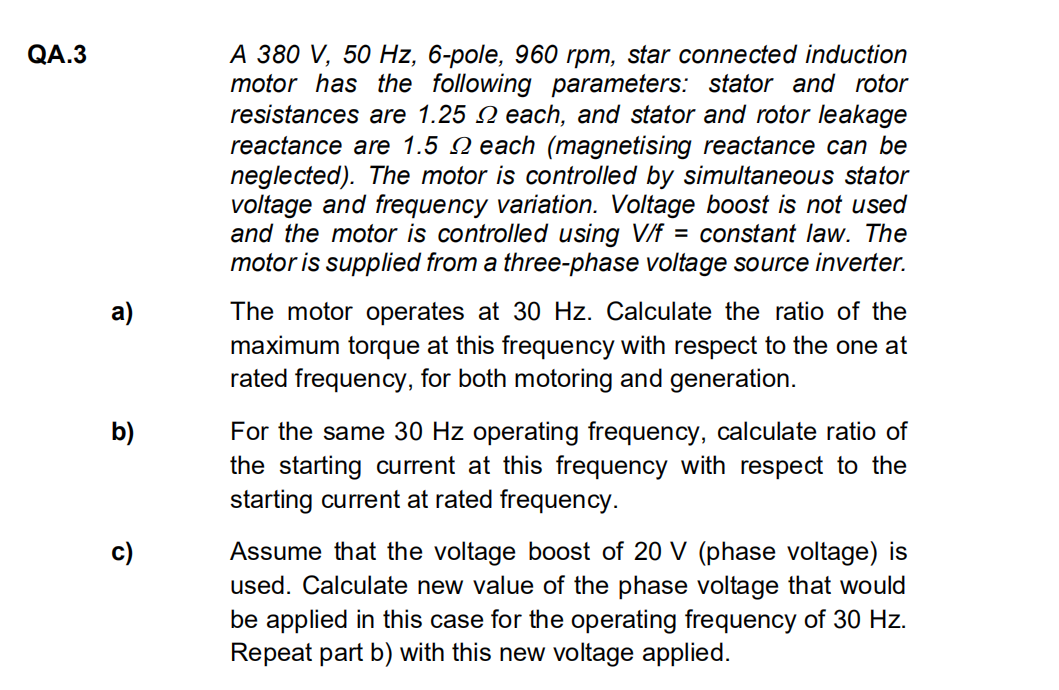QA.3 A 380 V, 50 Hz, 6-pole, 960 rpm, star connected induction motor has the following parameters: stator and rotor resistances are 1.25 each, and stator and rotor leakage reactance are 1.5 each (magnetising reactance can be neglected). The motor is controlled by simultaneous stator voltage and frequency variation. Voltage boost is not used and the motor is controlled using V/f = constant law. The motor is supplied from a three-phase voltage source inverter. The motor operates at 30 Hz. Calculate the ratio of the maximum torque at this frequency with respect to the one at rated frequency, for both motoring and generation.
QA.3 A 380 V, 50 Hz, 6-pole, 960 rpm, star connected induction motor has the following parameters: stator and rotor resistances are 1.25 each, and stator and rotor leakage reactance are 1.5 each (magnetising reactance can be neglected). The motor is controlled by simultaneous stator voltage and frequency variation. Voltage boost is not used and the motor is controlled using V/f = constant law. The motor is supplied from a three-phase voltage source inverter. The motor operates at 30 Hz. Calculate the ratio of the maximum torque at this frequency with respect to the one at rated frequency, for both motoring and generation.
Introductory Circuit Analysis (13th Edition)
13th Edition
ISBN:9780133923605
Author:Robert L. Boylestad
Publisher:Robert L. Boylestad
Chapter1: Introduction
Section: Chapter Questions
Problem 1P: Visit your local library (at school or home) and describe the extent to which it provides literature...
Related questions
Question

Transcribed Image Text:QA.3
a)
b)
c)
A 380 V, 50 Hz, 6-pole, 960 rpm, star connected induction
motor has the following parameters: stator and rotor
resistances are 1.25 each, and stator and rotor leakage
reactance are 1.5 each (magnetising reactance can be
neglected). The motor is controlled by simultaneous stator
voltage and frequency variation. Voltage boost is not used
and the motor is controlled using V/f = constant law. The
motor is supplied from a three-phase voltage source inverter.
The motor operates at 30 Hz. Calculate the ratio of the
maximum torque at this frequency with respect to the one at
rated frequency, for both motoring and generation.
For the same 30 Hz operating frequency, calculate ratio of
the starting current at this frequency with respect to the
starting current at rated frequency.
Assume that the voltage boost of 20 V (phase voltage) is
used. Calculate new value of the phase voltage that would
be applied in this case for the operating frequency of 30 Hz.
Repeat part b) with this new voltage applied.

Transcribed Image Text:Induction motor torque dependence on the slip can be given for rated frequency, rated voltage
operation as:
Rr
S
Te(s) = =
3P
V₂2²
2πfn
2
(R₁ + Rr)² + (X₁s + Xır) ²
Maximum torque under the same conditions can be expressed as:
3P
1
Tem Te(s = ±Sm)
-
· V₂2².
4πfn
Rs ± √√R² + X²
V
Expert Solution
This question has been solved!
Explore an expertly crafted, step-by-step solution for a thorough understanding of key concepts.
Step by step
Solved in 6 steps with 6 images

Knowledge Booster
Learn more about
Need a deep-dive on the concept behind this application? Look no further. Learn more about this topic, electrical-engineering and related others by exploring similar questions and additional content below.Recommended textbooks for you

Introductory Circuit Analysis (13th Edition)
Electrical Engineering
ISBN:
9780133923605
Author:
Robert L. Boylestad
Publisher:
PEARSON

Delmar's Standard Textbook Of Electricity
Electrical Engineering
ISBN:
9781337900348
Author:
Stephen L. Herman
Publisher:
Cengage Learning

Programmable Logic Controllers
Electrical Engineering
ISBN:
9780073373843
Author:
Frank D. Petruzella
Publisher:
McGraw-Hill Education

Introductory Circuit Analysis (13th Edition)
Electrical Engineering
ISBN:
9780133923605
Author:
Robert L. Boylestad
Publisher:
PEARSON

Delmar's Standard Textbook Of Electricity
Electrical Engineering
ISBN:
9781337900348
Author:
Stephen L. Herman
Publisher:
Cengage Learning

Programmable Logic Controllers
Electrical Engineering
ISBN:
9780073373843
Author:
Frank D. Petruzella
Publisher:
McGraw-Hill Education

Fundamentals of Electric Circuits
Electrical Engineering
ISBN:
9780078028229
Author:
Charles K Alexander, Matthew Sadiku
Publisher:
McGraw-Hill Education

Electric Circuits. (11th Edition)
Electrical Engineering
ISBN:
9780134746968
Author:
James W. Nilsson, Susan Riedel
Publisher:
PEARSON

Engineering Electromagnetics
Electrical Engineering
ISBN:
9780078028151
Author:
Hayt, William H. (william Hart), Jr, BUCK, John A.
Publisher:
Mcgraw-hill Education,